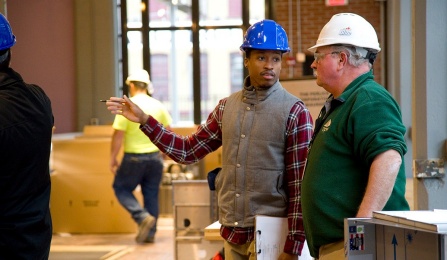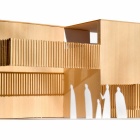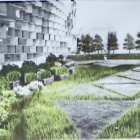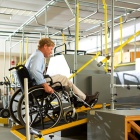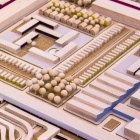MArch: 3-Yr. Track Curriculum
Today's grand global challenges make clear how the design of place and space effects the health of our society - from the way we interact and connect, to human impact on the environment, to our physical and emotional well-being, to the cultivation of economic, cultural and social opportunties for all.
Architecture is a comprehensive and highly interdisciplinary profession equipped to tackle large-scale challenges as diverse as climate change, an historic pandemic, and new waves of migration around the world. Indeed, our professions are being called upon to design the solutions - with new partners, new ideas, and new approaches. Together we can create places that enrich, sustain and connect people and communities.
The only prerequisite for an MArch at UB is a passion for design and an ambition to build a better world. Students from any undergraduate background are welcome to apply to the 3-year MArch track.
UB's 3-year MArch program is designed as a path of entry into the architecture profession for students without a qualifying undergraduate background in the field. A bachelor’s degree or higher from a regionally accredited four-year US college or university, or an equivalent credential from a qualifying international institution with, is all that is required. There are no architectural or studio coursework prerequisites. Students enter our program with degrees in the liberal arts, natural sciences, arts, urban planning and the social sciences. Others are early professionals seeking a career change. The 3-year Master of Architecture program is NAAB-accredited and provides you with a professional degree.
The camaraderie and sense of community among our 3-year students supports a collaborative and highly interactive studio culture. All students begin the 3-year MArch in the fall semester to support this defining culture of our program.
Meet our students
The program: from design fundamentals to focused research
The program builds your foundation in the fundamentals of design and "thinking through making" while offering paths for focused research in the final two years of the program. Courses in architectural media, drawing and an introductory design studio round out the first year. Students may opt to explore our graduate research groups which foster curricular and scholarly inquiry into fields including inclusive design, ecological practices, material culture, situated technologies and urban design.
Featured work from the 3-year program
3 Year Master of Architecture (MArch) Curriculum- FALL 2024
Curriculum Effective Fall 2024
| Semester 1: Fall | ||
| ARC 501 | Design Studio 1 | 6 |
| ARC 511 | Architectural Media 1 | 3 |
| ARC 531 | Architectural History 1 | 4 |
| ARC 541 | Environmental Systems 1 | 3 |
| Total Semester Credits | 16 | |
| Semester 2: Spring | ||
| ARC 502 | Design Studio 2 | 6 |
| ARC 512 | Architectural Media 2 | 3 |
| ARC 534 | Architectural History 2 | 4 |
| ARC 552 | Structures 1 | 3 |
| Total Semester Credits | 16 | |
| Semester 3: Fall | ||
| ARC 503 | Design Studio 3 | 6 |
| ARC 553 | Structures 2 | 3 |
| ARC 611 | Architectural Media 3 | 3 |
| ARC 573 | Environmental Systems 2 | 3 |
| Total Semester Credits | 15 | |
| Semester 4: Spring | ||
| ARC 504 | Design Studio 4 | 6 |
| ARC 542 | Construction Technology | 4 |
| ARC 575 | Environmental Systems 3 | 3 |
| ARC 582 | Professional Practice | 3 |
| Total Semester Credits | 16 | |
| Semester 5: Fall | ||
| ARC 605/7 or ARC 567+ARC 616 | Research Studio Or Directed Research | 6 |
| ARC 555 | Structures 3 | 3 |
| ARC 562 | Architectural Theory | 3 |
| ARC 697 or ARC 616 | Portfolio or Research Methods | 3 |
| Total Semester Credits | 15 | |
| Semester 6: Spring | ||
| ARC 606/8 or ARC 699 | Research Studio or Thesis | 6 |
| ARC xxx | Elective | 3 |
| ARC xxx | Elective | 3 |
| Total Semester Credits | 12 | |
| Total Required Credits | 90 |
Students are allowed to take a maximum of two independent study courses (6 credits) for elective credit in the program.
Directed Research must be taken the semester before Thesis. Students must have a mininum GPA of 3.5 or higher to register for Directored Research and Thesis.
Students must complete a Thesis or Portfolio as their culminating experience for graduation.
Advanced Standing:
Students in this program may be eligible to receive advanced standing based on prior work. Receiving advanced standing decreases the total number of credits required in the program and may let you move on to the next course in sequence. If you believe your academic background in architecture may allow for advanced standing, please follow the instructions here. You will need to complete an electronic advanced standing form for each specific course, confirm through your transcript that you have received a grade of B or higher in the equivalent course(s) taken during your undergraduate studies and upload the undergraduate course syllabi for each course. Any course request will be reviewed by the Associate Chair and faculty and students will be notified of the decision before the fall semester begins.
Explore our Graduate Research Groups
Courses
Develop versatile skills with our courses: focused, practical, and relevant
